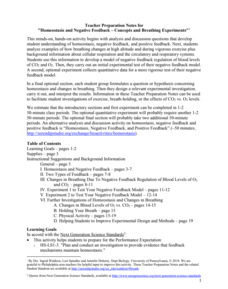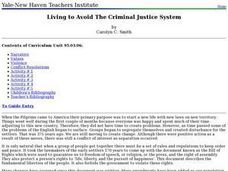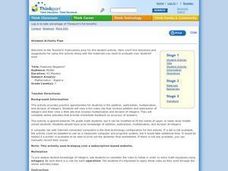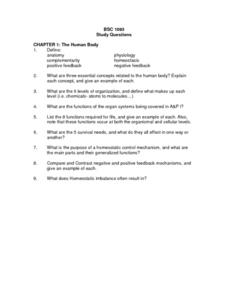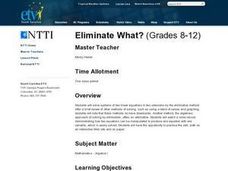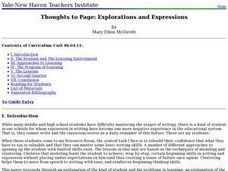Serendip
Homeostasis, Negative Feedback, and Positive Feedback
So many bodily activities depend on homeostasis! Give learners a solid background to understand the basic process of the human body. Scholars first examine negative feedback loops contributing to body temperature regulation and then a...
Serendip
Homeostasis and Negative Feedback – Concepts and Breathing Experiments
More asthma attacks happen at higher altitudes, but why? Scholars complete worksheets, learning about homeostasis and feedback related to breathing. Then, they work in small groups to experiment with breathing in limited amounts of...
Curated OER
Black Skin, White Justice: Race Matters in the Criminal Justice System
Young scholars examine the effects of race in the criminal justice system. As a class, they brainstorm a list of instances when the offender has been an African American and he is not treated fairly in court based on his race. They...
Curated OER
Feedback and Flowcharts
Sixth graders explain what a negative feedback system is and they distinguish it from a positive feedback system. They describe examples of how negative feedback is used in both nature and technology. , Students define homeostasis, and...
Curated OER
Living to Avoid The Criminal Justice System
Students brainstorm a list of negative stereotypes in the African-American society. In groups, they develop ways to decrease the chance of them living in poverty and being in trouble with the law. They develop ways to solve problems...
Curated OER
Positively Negative?
Students practice the addition, subtraction, multiplication, and division of integers. They view a video clip on addition and subtraction of integers. Students observe a Web site that reviews multiplication and division of integers....
Curated OER
Making a Brain: Aritifical Neural Network
Students explore how the brain works. In this nervous system lesson plan, students create a network of "neurons" to simulate how the nervous system and the brain work together.
Curated OER
The Human Body Study Questions
In this human body study question worksheet, pupils define 6 words associated with the human body. They answer 8 short answer questions about the organization and function of the organ systems and organization structure of the human body.
Curated OER
Steller Web Spinning Mystery
Students investigate what a system is in the scientific world. They watch a video of the Stellar seals of Alaska and develop clues as to why the seals are leaving. They discover through the clues they discover, how the components of the...
Curated OER
Beauty is More Than Skin Deep: Examining the Positive and Negative Depictions of Physical Appearance in Children's Films
Third graders compare and contrast different versions of the same story. They recognize our differences, identify qualities that make us special and unique individuals, and create a 'Wanted' poster illustrating a special quality.
Curated OER
Eliminate What?
Learners are introduced to the elimination method in Algebra. As a class, they solve two linear equations with two unknowns using this new method. They discuss the positive and negative aspects of using this method to solve problems. ...
Curated OER
Multicultural Issues and the Law: Gender and Race Based Schooling
Students examine the problems associated with gender based and race based education. In groups, they research the history of education and the laws that have changed education and impacted lives. They brainstorm a list of the positives...
Curated OER
Visual Communication of Quantative Data
Students collect and analyze data based on academic performance. In this statistics lesson, students create graphs and analyze the data they created. They use positive, negative and no correlation to analyze the data.
Curated OER
Why Do We Suffer From The Rights Of Others?
Students examine how diversity within populations has caused problems. In groups, they develop their own definitions of racism and discrimination. They participate in role-plays in which they gather the appropriate techniques to deal...
Curated OER
Energy Sources
Students identify natural resources and describe the difference between renewable and non-renewable resources. They also identify the disadvantages and advantages of the resources.
Curated OER
Hold Off on the Headphones
Students determine that waves carry energy and information from one place to another. They determine that wavelength, frequency and wave speed are related and describe that sound is a longitudinal wave whose speed depends on the...
Curated OER
Thoughts to Page: Explorations and Expressions
Young scholars are introduced to the correct techniques to use for proper writing. In groups, they practice the use of clustering to help them organize their thoughts and identify the main idea of their paper. To end the lesson, they...
Curated OER
Paw-er up for PowerPoint
Sixth graders explore how to transfer research material into a PowerPoint Presentation.

